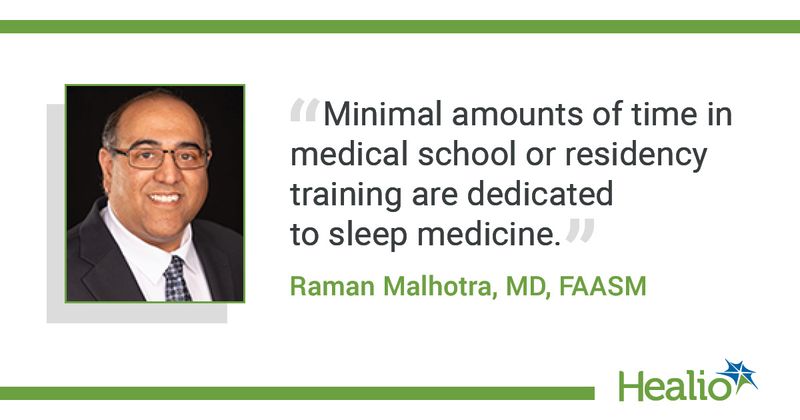Q&A: Bringing attention to risks, disparities in untreated obstructive sleep apnea
Left undiagnosed and untreated, obstructive sleep apnea can result in several poor consequences related to health, work and relationships, according to a press release from the American Academy of Sleep Medicine, or AASM.
Further, some undiagnosed patients belonging to certain racial groups may have trouble accessing resources to get diagnosed and treated because of health disparities.

With people who are secretly suffering from OSA in mind, the AASM in collaboration with the CDC has launched the “More than a Snore” campaign to raise awareness of the disorder and to urge this group to get treated, according to the release.
To learn more about OSA, risk factors of the disorder and the campaign’s goals, Healio spoke with Raman Malhotra, MD, FAASM, professor of neurology in the sleep medicine section at Washington University School of Medicine and AASM past president.
Healio: How prevalent is undiagnosed OSA? Why are there many undiagnosed cases and how does this impact the people who are secretly suffering from OSA and those around them?
Malhotra: OSA affects nearly 30 million adults in the U.S. Approximately 80% of these cases are undiagnosed, costing the U.S. more than $149 billion annually in health care costs, lost work productivity and workplace and motor vehicle accidents. There are many contributing factors for the substantial number of undiagnosed cases. The symptoms of OSA, such as sleepiness and tiredness, come on gradually and can be dismissed for other reasons such as not getting enough sleep. Even when these concerns are discussed with a medical provider, they may not be properly evaluated due to the provider’s potential lack of training in proper evaluation and treatment of this very common condition. Minimal amounts of time in medical school or residency training are dedicated to sleep medicine. Not treating OSA can impact one’s quality of life. OSA can impact academic or job performance, being able to attend social or family functions, mood, anxiety, pain and overall long-term health. Not treating OSA can also affect relationships between spouses, children, parents or coworkers.
Healio: Besides poor sleep quality, what other factors may a patient with OSA struggle with or be at risk for?
Malhotra: Patients with OSA may struggle with worsened mood, decision making, cognition, anxiety, pain and immune function, just to name a few. OSA can negatively affect other underlying medical disorders that patients are suffering from such as hypertension, diabetes, dementia, asthma and headaches. Patients with OSA are found to have higher rates of car accidents, stroke, heart attacks, cardiac arrhythmias and glucose intolerance (diabetes).
Healio: What are the current treatment options for OSA?
Malhotra: In adults, continuous positive airway pressure (CPAP) is the most common treatment for OSA and uses air pressure provided through a mask to keep the throat open during sleep. Although this is a highly effective treatment for many, fortunately we have other treatment options available for those who do not respond to or tolerate this treatment. Mandibular advancing oral appliances made by dental sleep specialists are effective in treating sleep apnea in many patients, and avoiding sleeping on one’s back can also treat some people. Additionally, weight loss can improve sleep apnea. Surgical options can also be considered in the appropriate patients. This may include upper airway surgery, jaw surgery or a hypoglossal nerve stimulator placement.
Healio: Can you explain what inspired the launching of the “More than a Snore” campaign?
Malhotra: The campaign is a collaborative project funded through a grant awarded to the AASM by the CDC’s National Center for Chronic Disease Prevention and Health Promotion. This multi-year campaign was created through the Count on Sleep partnership, a collaboration between several professional and patient-focused organizations led by the AASM and the Sleep Research Society. Other partnering organizations are the Alliance of Sleep Apnea Partners, American Academy of Dental Sleep Medicine, American Academy of Otolaryngology – Head and Neck Surgery, American College of Chest Physicians, American Society for Metabolic and Bariatric Surgery, American Thoracic Society and National Sleep Foundation. These organizations are committed to raising awareness of OSA and providing expertise to educate the public and health care professionals.
Healio: What is the main purpose of the campaign? How does the campaign aim to help those with OSA?
Malhotra: One of the goals, not only of the AASM but its partners in this project, is to reduce the number of undiagnosed OSA patients and have them get appropriate treatment. The CDC recognized the impact that OSA has on our country’s population and that there are specific groups of patients in our population who suffer from sleep apnea; however, due to health disparities in our system, these groups have numerous barriers to getting diagnosed and treated. These groups include Black, Native American and Latino populations. We wanted to specifically target our awareness campaign to these groups along with the medical providers that serve them to increase awareness about this chronic health condition. We are not only creating population-specific awareness campaigns, but also creating tools for medical providers to recognize and treat OSA in their patients more easily.
Healio: What are some upcoming plans of the “More than a Snore” campaign aside from raising awareness?
Malhotra: Through this campaign, we will continue outreaching to health care professionals with resources and education to help them integrate care for OSA into their practice and widen our reach to individuals who may have OSA to encourage them to seek care.We will soon have resources for public health professionals to encourage public programs on OSA. We also plan to address OSA health to populations affected by sleep health disparities with community stakeholders.
For more information:
Raman Malhotra, MD, FAASM, can be reached at ramanmalhotramd@gmail.com.
Reference:
New campaign to raise awareness that sleep apnea is ‘More than a Snore’. https://aasm.org/new-campaign-to-raise-awareness-that-sleep-apnea-is-more-than-a-snore. Published Feb. 6, 2023. Accessed Feb. 8, 2023.

